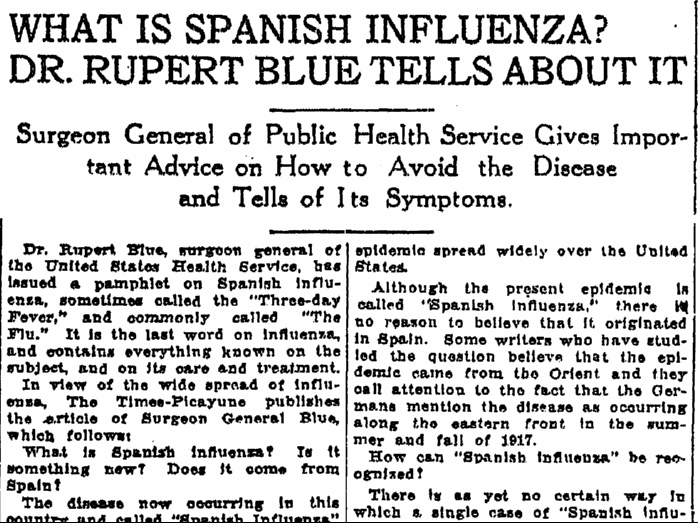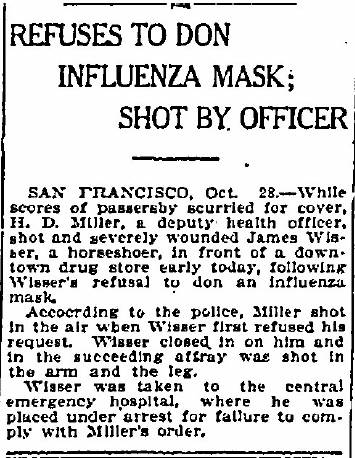Introduction: In this article, Gena Philibert-Ortega researches old newspaper articles to learn about the 1918 Spanish Flu Pandemic, a three-year disaster that killed approximately 50 million people worldwide and unquestionably affected the lives of any of your ancestors living in the years 1918-1920. Gena is a genealogist and author of the book “From the Family Kitchen.”
Influenza is a disease, makes you weak all in your knees;
‘Tis a fever ev’ybody sure does dread;
Puts a pain in ev’y bone, a few days an’ you are gone
To a place in de groun’ called de grave.
—“Influenza,” lyrics found on American Memory: the John and Ruby Lomax 1939 Southern States Recording Trip. Song sung by Ace Johnson, Clemens State Farm, Brazoria, Texas, April 16, 1939.
Earlier this year, despite having had a flu shot, I ended up catching the flu. Anyone who has had the flu knows how truly miserable it is. When you are suffering from it, you can easily understand how someone could die from its symptoms. Although still deadly, the flu does not strike the terror in people’s minds that it once did. In fact many people take a wait and see approach, frequently opting not to get the yearly influenza vaccination shot.
When many people think of our ancestors and the flu, they automatically think of the 1918 Spanish flu pandemic—and with good reason. This was one of the deadliest flu pandemics in history.

From January 1918 to December 1920, this flu pandemic killed approximately 50 million people worldwide, nearly 675,000 in the United States alone.[i] By contrast, 16 million lives were lost during World War I, which was still ongoing during the Spanish flu pandemic’s first year. Why was this flu different from previous forms of influenza? One significant difference in this deadly strain was that young adults were affected just as much as the usual at-risk groups: young children and the elderly.[ii]
This influenza pandemic touched everyone’s lives whether they came down with the virus or not. Efforts to curb the spread of the flu disaster included requiring people to wear facemasks, and discouraging public meetings. The committee of the American Public Health Association decreed that non-essential meetings and gatherings in crowded rooms were dangerous. Some of the APHA recommendations included the closing of “saloons, dance halls, and cinemas.”[iii]

The implementation of these public safety health precautions shows how seriously the influenza pandemic was taken. A startling example of this is described in the following article from a 1918 Washington newspaper, reporting that a public health officer shot a person on the street who refused to don a mask.

The vast movement of troops caused by World War I meant that an illness that would normally be quickly contained instead had worldwide consequences. While the 1918 pandemic is the one that often gets remembered, there have been other epidemics including those of a more recent nature, like the recent Swine Flu. There is no doubt that the 1918 pandemic wasn’t the only one that may have affected your family. According to the website flu.gov there have been four flu pandemics since 1918.[i]
Do you have an ancestor who had the flu during the Spanish flu pandemic? Want to learn more about the history of that outbreak? Good sources for researching historical epidemics are the books Encyclopedia of Plague and Pestilence: From Ancient Times to the Present by George Childs Kohn, and America’s Forgotten Epidemic: The Influenza of 1918 by Alfred W. Crosby.
Don’t forget to search for old newspaper articles about the flu on GenealogyBank. By searching on the word “influenza” and narrowing your search by date and place you will be able to find articles of how the pandemics affected your ancestor’s community and other parts of the United States.
[i] Pandemic Flu History. Available at http://www.flu.gov/pandemic/history/index.html.
[ii] The Deadly Virus: The Influenza Epidemic of 1918. National Archives and Records Administration. Available at http://www.archives.gov/exhibits/influenza-epidemic/.
[iii] The Influenza Pandemic of 1918. Available at http://virus.stanford.edu/uda/.

My Great Grandmother died 8 days after my Grandmother was born from the Spanish Flu in October of 1918.
Melody,
Thank you so much for sharing your family’s story.
Gena
My grandfather’s first wife died in the epidemic. She was in her early 20’s and there was a double funeral because her best friend died at the same time. This was in Kirksville, Missouri. He remarried and my father was born in 1921. I am one of eight siblings and I think we would not be here were it not for this tragedy.
Teresia,
This flu was no respecter of age and the lives of so many young adults were taken during the epidemic. It’s interesting how something like an epidemic can have a major impact on our lives.
Thank you so much for sharing your family’s story.
Gena
Why don’t more people wear masks and wash their hands? Today with this virus… it’s so sad.
Mattie…it is so important that we wear masks and wash our hands. Unfortunately, not everyone agrees. Take care and stay healthy!–Gena
My father’s parents and his baby sister died in 1918 from the flu pandemic leaving him an orphan in Greene County Illinois.
Some family members say he went from relative to relative and also a orphanage that he kept running away from because of abuse by the staff.
Rosalie,
What a tragedy for your father to live through as a child. Thank you for bringing up an important effect of the pandemic, children being orphaned.
Gena
In Oct of 1918 it was a tragic time for my Mom’s Family who were living in Riverside, NJ when the Spanish Flu Pandemic turned their world upside down. Her mother Mariangela had just lost baby brother John who did not come home from the hospital. He would have been their 6th child. My Mom was only 6 years old. She had 2 sisters, Carrie age 9 and Rose age 7; and 2 brothers, James age 4 and Frank age 2. All she remembered of her mother was that she was very Pretty, but was sick with the Flu with the rest of the children. Her Mom sent her across the field to the next street to get Grandmom as Mom’s sister Carrie was so sick with the flu, Mariangela could not take care of her. Carrie died that day in Grandmom’s arms on 4 Oct 1918. Mariangela, weakened from childbirth could not recover from the flu and also passed away on 6 Oct 1918; she would have been 27 years old that November. The other children had to be hospitalized as they were so sick. They had so much death that they had to make mass graves at St. Peter’s Cemetery in Riverside, NJ and most likely many other parts of the US and the world.
Marti,
Thank you so much for sharing your mother’s story. How terrible for your mother that she endured all that loss at such a young age.
Thank you for taking time to read the article and sharing your family history.
Gena
Gena…
Thank you for your articles. The comparisons to the present are amazing. As my sister sits sewing masks, we were wondering if you found photos of the masks they designed.
Stay safe at Home!
Pam, I looked in old magazines, newsletters, and websites and I did not find a sewing pattern for a 1918 mask. That’s not to say they didn’t exist but the closest I found was some brief instructions in a newspaper article. It appears that people were encouraged to use layers of gauze for their masks or to use a handkerchief. I would love to find evidence that women were sewing masks like they are today but I have yet to uncover that. Thank you to your sister for her mask making efforts. Take care!–Gena
According to family stories, my paternal grandmother, Maud, traveled from northwest Mississippi to the State Capital during the pandemic to help her sister Katie with her children while Katie nursed an ill husband. The husband recovered, but my grandmother Maud caught the illness and died, leaving three young children (my father, and his two younger siblings) for her husband to rear. Other aunts volunteered to take one each of the children, but my great-grandmother insisted that the children not be separated, and so she and her husband reared them together. My widowed grandfather then remarried, bringing a “new” mother and her daughter home with him. I’ve often wondered how many descendants’ lives were impacted because my grandmother Maud sacrificed her own health to help a sister.
Mary-Neal, how heartbreaking that loss must have been to her family. I’m so glad that you are telling her story so her sacrifice is remembered. Thank you for sharing that. Stay safe, Gena
My grandfather died Nov. 17, 1918, of this influenza. My mom was just 13 months old. His parents were afraid to enter the home. I couldn’t figure out why, until now. They were scared. Sad time.
Barbara, so much of what is happening now reminds us of the events of the 1918 pandemic. In 1918, someone could wake up feeling fine and be dead by the next morning. It was a scary time. And it killed those that were young and healthy. So that makes sense that your family was scared. Take care and stay safe–Gena
I would love to see numbers of deaths before and after masks were mandatory. I believe in wearing a mask and would love to have past experience to back it up.
Laura, you could probably find that by searching the historical newspapers on GenealogyBank or referring to a website like the Influenza Encyclopedia (https://www.influenzaarchive.org/browse/titles/a.html) or even a book like The Great Influenza by John Barry. –Gena
My great grandmother was living in Cleveland. My mother told me that Freida had gone across town to help others that were ill with the flu, and this is how she contracted it. Freida was 31 years old and had 5 children at home, one of them my father. All but the youngest who was about 3 years old were taken to the Jones Home for Friendless Children. It is unknown how long they stayed there but I have records which show that my dad and his sister were still in a rehabilitation center where they were taught skills like gardening. I located records from 1926 which show my aunt as the only girl still in foster care. My father had “escaped” according to the records and he was 21 years old. My father was really 17. He left the home an enlisted in the Army where he spent 2 years serving until they found out he lied about his age and was Honorably Discharged. My father led a troubled life until he died. He struggled with alcoholism till he died. I can’t help but wonder how different he and his siblings may have been had they grown up with a mother.
Judith, what a tragedy. The flu left so many victims, including those left behind by their loved ones who died. Thank you for sharing your family’s experience with us.–Gena
I am so appreciative for this information. I wore a mask before it was required and had already left work and put myself in quarantine. I am 70 and the matriarch of my family. It has been hard not having family gatherings; missed birthdays, graduations, and holidays that we would normally gather for. It’s best and we love each other enough to stay together-apart! Our young people are always online; they need to search out this article or similar ones and pay heed to the confirmed data.
Thank you so much Phyllis! It is indeed a difficult time and hopefully we will be able to attend those birthdays and other celebrations in 2021.-Gena